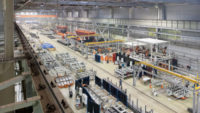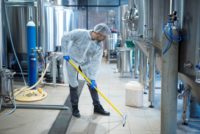Over the past 20 months, many industrial facilities have implemented a variety of intensive cleaning and disinfecting regimens to keep their facilities and their staff healthy. But as we move into 2022 and with the pandemic ebbing, some administrators are reconsidering these measures, wondering if they are still necessary.
Their timing is right. While we do not know how bad things will get this winter, as of November 2021, the number of infections and deaths from COVID-19 has gone down significantly. Further, several public health officials predict that even if there is an upsurge of infections this winter, it will be far smaller than what we saw in the winter of 2020.
But there is another reason industrial facilities are reconsidering these intensive cleaning and disinfecting measures. The cause of concern is disinfectants. While they have certainly served us well, historically and during the pandemic, we also know that chemical disinfectants can be detrimental to the product user, building user, and environment.
Making matters worse, we are now learning that many industrial facilities, offices, schools, health care centers, and others have been over disinfecting. So much so, it even has a name: indiscriminate disinfecting.
“Disinfectants and sanitizers are essential preventive agents against the coronavirus disease,” according to a recent study published in Environmental Science and Pollution Research. “However, the pandemic crisis was marred by undue hype, which led to the indiscriminate use of disinfectants and sanitizers.” *
The researchers went on to say that “despite [disinfectants] demonstrating a beneficial role in the control and prevention of COVID-19, there are crucial concerns regarding the large-scale use of disinfectants and sanitizers, including the side effects on human and animal health along with harmful impacts exerted on the environment and ecological balance.”
So, when it comes to cleaning and disinfecting to protect the health of their staff, it looks like administrators of industrial locations have two key concerns to grapple with in the new year:
- Should they return to the cleaning programs in place before the pandemic?
- If not, should they continue using substantial amounts of chemical disinfectants?
Let’s take a closer look at both to find the answers.
Aggressive cleaning and disinfecting
Many public health officials and leaders in the professional cleaning industry view the coronavirus pandemic as a long-overdue wake-up call. While it’s been 102 years since the last pandemic, the consensus today is that we will not be waiting another century for the next one.
“Pandemics like COVID-19 and the Spanish flu [of 1918] are relatively likely,” said William Pan, Ph.D., associate professor of global environmental
|
Pandemic Odds Every year, the odds of having another pandemic as severe as COVID-19 increases by 2 percent, according to Professor Pan. This means another pandemic may occur in the next 50 years, not 100, as happened with the Spanish Flu. |
health at Duke University. “Understanding that pandemics aren’t so rare should raise the priority of efforts to prevent and control them in the future.”
One key reason for this is the much greater globalization of the world. A disease that starts in China, for instance, can quickly spread to other countries in a variety of different ways.
And this is nothing new. The Great Plague of London first started in China in 1334, and it spread along trade routes between China and England, wiping out entire towns as traders entered these towns. Ultimately, Europe lost 25 million people due to the Great Plague of London.
This tells us that industrial facilities can’t let down their guard. With increased globalization and the anticipation of more frequent pandemics, we cannot turn to older cleaning and disinfecting measures. More thorough and effective infection control and prevention strategies are needed from now on. However, does this mean huge volumes of chemical disinfectants are necessary?
The use of chemical disinfectants
This leads us to our second quandary: should the administrators of industrial facilities continue using substantial amounts of chemical disinfectants?
So we are all on the same page, chemical disinfectants refer to liquid disinfectants that are EPA-registered, meaning they are approved for use in the United States. Typically, they are diluted with water per the manufacturer’s recommendations. Further, most disinfectants are manufactured with quaternary ammonium compounds, better known as QACs or “quats.”
We mentioned earlier that disinfectants could be harmful to the user and environment; this is especially true if they contain QACs. “The increased use of QACs is concerning as exposure to these compounds has been associated with adverse effects on reproductive and respiratory systems,” reports a recent research paper.**
In fact, the researchers found that the increased use of disinfectant was so widespread during the pandemic that it was even found in dust collected from surfaces. “Our findings raise concerns about increased [and ongoing] exposure to these chemicals during the ongoing pandemic.”
If we must continue an active cleaning and disinfecting routine going forward, but we need to use fewer chemical disinfectants, what options do administrators have? One technology getting considerable attention is the use of ultraviolet (UV) technology, and it’s UV-C light that’s of particular interest.
UV-C light is produced electronically using UV-C lamps. These lamps are often called germicidal lamps because they can disrupt or deactivate the DNA and cell functions of potentially harmful microorganisms. This makes them an effective way to eliminate (kill) bacteria, germs, and pathogens on surfaces — even those that can cause the coronavirus.
A study in the American Journal of Infection Control concluded that “SARS-CoV-2 could effectively be inactivated by UV-C irradiation.” Additionally, the researchers pointed out:
UV-C . . . is a highly effective method to inactivate the coronavirus SARS-CoV-2, even at the higher viral load levels found in research laboratories or diagnostic material taken from the respiratory tract of COVID-19 patients.***
During the pandemic, public transportation systems used UV-C systems in busses and subways to disinfect the air and surfaces. They are also installed inside air ducts to disinfect air as it is released.
In an industrial facility, administrators can place UV-C air purifiers or UV-C lamps in many areas of the facility, such as restrooms, kitchens, even in open work areas that need special disinfecting attention. The one caveat is that once these systems are turned on, while they are operating, no one should be in the area where the purifier or lamps are being used. Exposure to UV-C can be harmful to the skin and eyes.
To help ensure safety, at least one manufacturer supplies remote controls so that these systems can be turned on and off before building tenants enter areas where the UV-C systems are being used.
Hopefully, we have answered the questions put forth above.
Can we return to cleaning procedures in place before the pandemic?
Not if we want to be safe, and more important, ensure the health and safety of our cleaning workers and building users.
Should we continue using large amounts of chemical disinfectants?
When the pandemic began, administrators and cleaning professionals were scrambling to find ways to deal with the crisis, which is why we turned to chemical disinfectants so aggressively. But we have learned quite a bit since then. We need to investigate disinfecting alternatives. The use of UV-C is one to consider.
* A sanitizer reduces the microbial population on a surface, while a disinfectant all the germs and bacteria on a surface, provided it is used correctly and designed to target those specific pathogens.
** Zheng G, Filippelli G, Salamova A. Indoor Exposure to Commonly Used Disinfectants During the COVID-19 Pandemic. ChemRxiv. Cambridge: Cambridge Open Engage; 2020; A research paper.
*** Napolitano NA, Mahapatra T, Tang W. “The effectiveness of UV-C radiation for facility-wide environmental disinfection to reduce healthcare-acquired infections.” American Journal of Infection Control. December 2015.
Additional Source: “The role of disinfectants and sanitizers during COVID-19 pandemic: advantages and deleterious effects on humans and the environment,” by Dhama K, Patel et al., Environmental Science and Pollution Research, July 2021.


